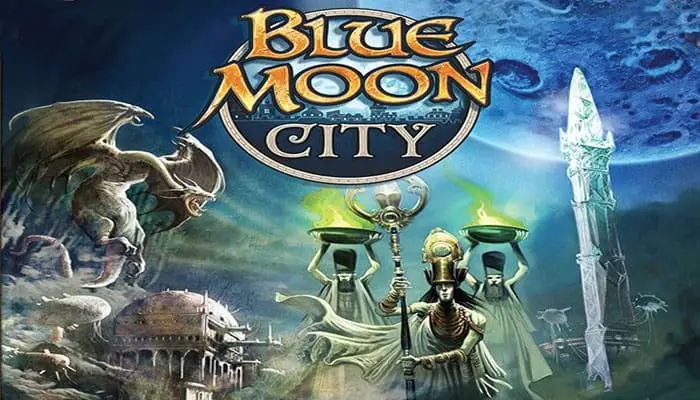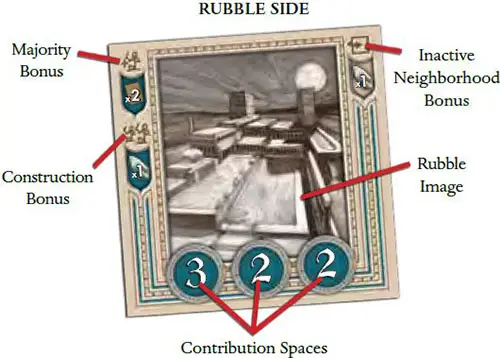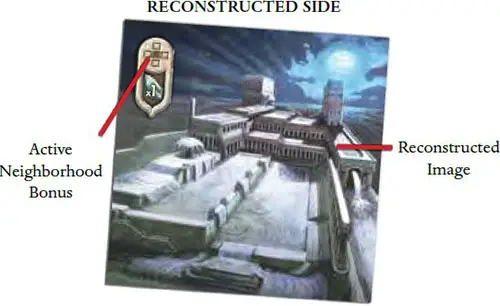
In Blue Moon City, you must take charge of the reconstruction of the great city and restore its sacred Obelisk. Throughout the game, you must move across the modular tile board, using contributions from the eight peoples of Blue Moon to rebuild the city's buildings.
After enough contributions, a building will be completed and each player that helped in the reconstruction will be granted rewards for their efforts. What's more, if you contribute to a building
in the presence of one of the mighty Dragons, they'll grant you a token of their appreciation. These rewards may be cards, golden dragon scales, or crystals: cards will help you make further building contributions, while golden scales can be traded for more crystals.
Gather up these valuable crystals, for they are needed to make Offerings to the Obelisk. The first player to make a certain number of Offerings wins the game!
Components

- 20 Double-sided Building tiles
- 4 Double-sided Expansion Building tiles
- 80 People Cards
- 4 Player miniatures
- 1 Double-sided Courtyard tile
- 40 Player markers
- 45 Crystal tokens
- 3 Dragon figures
- 12 Golden scale tokens
- 3 Counter Bases
- 1 Double-sided Obelisk
Basic Concepts
Building Tiles
The city of Blue Moon is represented in the game by a set of Building tiles. These tiles show 2 different stages of development: the rubble of a former building and its reconstructed version.
The Rubble side of each Building tile is composed of its Rubble image, Contribution Spaces, Majority Bonus, Construction Bonus, and Neighborhood Bonus.

Rubble Image: A depiction of a Building in ruins.
Contribution Spaces: Each Building tile has spaces that show a color and a number. These spaces show how many contributions are necessary to reconstruct the building.
The color refers to the type of card needed to contribute, and the number refers to the total value of cards that must be discarded.

Majority Bonus: Indicates the rewards granted to the player that makes the most contributions to the Building's Reconstruction.

Construction Bonus: Indicates the rewards granted to all the players that contribute to the Reconstruction. This includes the player that receives the Majority Bonus.

Neighborhood Bonus: Indicates the additional rewards granted to all players that contributed when an adjacent Building tile is reconstructed. This bonus is inactive while the rubble side is faceup.
After a Building has been reconstructed, the tile will be flipped over to its Reconstructed side and show only its Neighborhood Bonus, which is now active.

People Cards
The diverse peoples of Blue Moon are represented in the game by People cards. Each card has a value ranging from 1 to 3. These values represent your contribution to the reconstruction of the Buildings throughout the city.
Cards with a value of 1 or 2 often have special powers that can be used on your turn. Cards with a value of 3 have no special powers.

Setup
1 Start building the city by placing the Courtyard tile in the center of the table. (It's the only tile with both sides colored).
2Then, randomly place the 4 Starting tiles (marked with ( ) orthogonaly adjacent to the Courtyard with their Rubble side faceup.
) orthogonaly adjacent to the Courtyard with their Rubble side faceup.
3 Shuffle the remaining Building tiles and randomly add them with their Rubble side faceup to complete the city's layout, as indicated in the illustration.
Variant Setup: For more variety, place the Courtyard in the center and randomly add all other Building tiles (including the 4 Starting tiles) to complete the city layout.
Important: The Buildings with
belong to the Expansion Building tiles, therefore are not used in the base game. If you do not wish to use the expansion, return them to the box.

4 Attach the 3 Counter Bases to the 3 Dragon miniatures. Then, place them next to the city.
5 Place the Obelisk next to the city. Use the side corresponding to the current player count (printed on the Obelisk).
6 Place the Crystal tokens on one side of the Obelisk.
7 Place a number of Golden Scale tokens on the side of the Obelisk, based on the player count:
- 2 Players - 7 Golden Scales
- 3 Players - 10 Golden Scales
- 4 Players - 12 Golden Scales
Leave any unused Golden Scales in the game box.
8 Each player chooses a color. Place your Player Miniature on the Courtyard tile and the 10 corresponding Player Markers in front of you. In a 2- or 3-player game, leave the remaining Miniatures and Markers in the box.
9 Shuffle the People cards. Deal 8 to each player, and place the remaining deck of cards facedown next to the city.
Game Play
Randomly select a first player. The game plays in turns, starting with the first player, and proceeds clockwise. On your turn, go through the following phases in order:
- Movement Phase
- Contribution Phase
- Reset
- Pass Turn
Movement Phase
You may move your Miniature orthogonally up to 2 spaces along adjacent Building tiles. You may not move diagonally.
Moving is optional.
During your Movement Phase, you may discard as many cards as you wish to use their Power(s).
Example: Natasha is currently on the Hospice, but doesn't have any Red cards to contribute there. She has several Brown cards in her hand, and she sees that the City Residence tile requires Brown cards.
She is not allowed to move diagonally, so she moves 1 tile up and 1 tile to the left. This uses her 2 movement points for the turn, so she concludes her Movement Phase.
Contribution Phase
You may contribute to the reconstruction of the Building on which you end your movement (if you decided not to move, you may contribute to the reconstruction of the Building you are currently on) OR
If you end your movement on the Courtyard, you may make an offering to the Obelisk.
Contributing is optional.
To contribute to a Building's reconstruction, you must discard from your hand any number of cards that have a total value equal to or greater than 1 of the Contribution Spaces. All discarded cards must match the space's color. Then, after satisfying the Contribution Space's requirements, place 1 of your Player Markers on it. That contribution will no longer be available for any other players.
Important: Player markers are limited. If a player doesn't have any available markers, they cannot make a Contribution.
Example: Natasha just moved 2 spaces from the Hospice to the City Residence. Now, she can contribute to its reconstruction. The City Residence has 3 brown Contribution Spaces: 4, 3, 2.
Natasha then discards 2 brown cards with a total value of 3 to place her marker on the '3' space. The next player that ends their movement on the City Residence will only have 2 options of Contribution Spaces: 2 or 4.
You may contribute to a Building tile as many times as you like on your turn. However, each contribution is its own distinct action. As such, you may not use the same cards or any left-over value from a previous contribution to add to another contribution.
During your Contribution Phase, you may discard as many cards as you wish to use their Power(s). However, once played, the cards can no longer be used towards a contribution, unless their special power directly relates to a players contributions.
Example: Aman finished his movement on the Earth Temple. There are 3 available Contribution Spaces: 5, 4, 3 in red. He has a total value of 8 red (3, 2, 2, 1) in his hand.
Since he can make 2 different combinations that satisfy 2 different spaces - 5 (3 + 2) and 3 (2 + 1) - Aman can choose to make 2 contributions to the Fire Temple's reconstruction.
He discards the 4 red cards from his hand and places 2 Markers on the corresponding spaces on the Building tile.
Reset Phase
First, you may discard up to 2 People cards from your hand onto the faceup discard pile.
Then, from the deck, draw 2 cards more than the number you discarded. (Example: If you discard 0 cards, draw 2 from the deck).
If the deck runs out at any point during the game, reshuffle the discarded cards to form a new deck. Cards discarded in this phase do not add to your contribution or have their special powers activated.
You cannot skip the Reset phase.
Pass Turn
Pass the turn to the next player to your left.
Example: Having just contributed to the University, Laura assesses her hand. She decides that she doesn't need her 2 red cards right now, so she discards them.
She then draws 2 more cards than the amount she discarded, drawing a total of 4 (2 + 2) new cards from the deck.
Scoring Buildings
When a marker is placed on the last empty Contribution Space of a Building, its reconstruction is complete. Then, players that contributed to its reconstruction receive some of the following bonuses:

Majority Bonus: The player who has the most markers on the scoring Building receives the Majority Bonus. If there is a tie for most markers, the tied player with the leftmost marker receives the bonus.

Construction Bonus: Each player with at least 1 marker on the scoring Building receives the Construction Bonus. (This includes the player receiving the Majority Bonus!)

Neighborhood Bonus: Each player with at least 1 marker on the scoring Building receives the Neighborhood Bonus of each reconstructed Building orthogonally adjacent to the scoring Building. Even if you have multiple markers on the scoring Building, you only score a reconstructed Building's Neighborhood Bonus once.
After scoring a Building, players retrieve their markers on the scoring Building. Then, the Building tile is flipped to its reconstructed side. Any Miniatures or Dragons that are present return to the tile after it is flipped.
Available Bonuses
The available bonuses are Golden Scale tokens, Crystal tokens, and People cards. Place any Golden Scale tokens and Crystal tokens you receive in front of you, keeping your Crystals facedown so that only you know their values.
Place any cards you receive facedown in front of you without looking at them, and add them to your hand after your turn is over.
Golden Scales & Dragons
Golden Scales can be traded for Crystals if you manage to acquire enough of them. There are 2 ways to receive Golden Scale tokens:
Score a reconstructed Building OR
Make a contribution to a Building in the presence of a Dragon
Dragons

Dragons are the ancient protectors of Blue Moon and move through the city using the special card power.
Every time a contribution is made to the Building tile where any of the Dragons are, the contributor receives 1 Golden Scale as a token of the Dragon's appreciation.
You can receive Golden Scale tokens from different Dragons for the same contribution; however, if you make more than one contribution during your turn, you only receive the Golden Scale(s) for your first contribution.
Scoring Golden Scales
When the last Golden Scale token is taken from the pool, they are scored. While Golden Scales are limited, Scales that you gain, but can not collect because the pool ran out, still count towards your total for scoring.
The player with the most Golden Scale tokens receives 6 Crystals. If there is a tie, the tied players score 3 Crystals each. Then, they must return their Golden Scales to the pool.
All other players who have at least 3 Golden Scales gain 3 Crystals. Then, they must return their Golden Scales to the pool. Players who have fewer than 3 Golden Scales don't receive any Crystals. However, they keep their Golden Scales.
Crystals & Obelisk
Before the Dark Age, the Courtyard had been the social axis around which all city life rotated. In its center stood a towering Obelisk and, at its pinnacle, rested the Holy Crystal of Psi. Only by restoring the Holy Crystal of Psi, shattered during the war of succession, will Blue Moon City truly be rebuilt.
Crystals
Crystals are gained throughout the game and are used to reconstruct the most important monument in Blue Moon City: The Obelisk. Crystals gained must be kept facedown, concealing the amount from other players.
Important: Unlike Golden Scales and Player Markers, the Crystals in the game are unlimited. If the Crystal pool runs out, keep counting their score.
The Obelisk
The Obelisk has 11 spaces for Crystal Offerings for a 2-player game and 13 spaces in a 3+ player game, numbered from 7 to 12. The Obelisk spaces are filled from the bottom up, using Player Markers to track each Offering. If a player doesn't have a marker available, they cannot make an Offering.
Offering Crystals To The Obelisk
To contribute to the reconstruction of the Obelisk, players offer Crystals instead of cards.
The Offering must be made in the Courtyard, and it must satisfy the required amount of Crystals printed in the next available space of the Obelisk (moving from lowest value to highest).
If you make an Offering to the Obelisk in the presence of a Dragon, you do not receive any Golden Scale tokens. Unlike other Buildings, you may not make 2 or more Offerings to the Obelisk in a single turn without the use of particular cards' Special Powers.
Example: Laura moves 1 tile to the right, from the Royal Palace to the Courtyard. She wants to make an Offering to the Obelisk, so she checks to see which spaces are available.
The '7' spaces have all been taken, as have both of the '8' spaces. However, the '9' spaces are both open! Laura spends 9 Crystals, returning them to the pool, and places 1 of her markers on a 9 space.
End of the Game
A player wins the game as soon as they have made the following number of Offerings to the Obelisk:
- 2-player game: 6 offerings
- 3-player game: 5 offerings
- 4-player game: 4 offerings
If every Building tile in the city is rebuilt and no player has enough Crystals to make the necessary number of Offerings, play until every player has made as many Offerings as they can.
The player who has made the most Offerings to the Obelisk wins. Ties go to the player who has the most remaining Crystals. If this is also tied, the tied players share the victory.
Important: If all players run out of Player Markers (by placing them all on unfinished Buildings and the Obelisk) and none made enough Offerings to win the game, the game ends immediately in a draw.
Continue Reading






